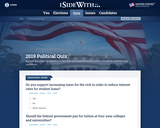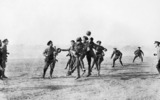
Students can answer questions to see how their political beliefs match their political parties and candidates.
- Subject:
- Civics and Economics
- Social Studies
- Material Type:
- Questionnaire
- Author:
- isidewith.com
- Date Added:
- 11/26/2019

Students can answer questions to see how their political beliefs match their political parties and candidates.

This is a daily review for standards 3.0A8 and 3NBT2. Two step word problems and finding unknowns. These can be copied and used in small group during math workshop or during whole group instruction.

This is a daily review for standards 3.0A8 and 3NBT2. Two step word problems and finding unknowns. These can be copied and used in small group during math workshop or during whole group instruction.

This is a visual communication board that allows students who are verbal or non-verbal to communicate how they are feeling when they are sick. Ask the student the question and have them touch or speak a response to communicate how they are feeling.

Three Column Notes is a great resource to use as students read and pace themselves through reading material.

Three Column Notes is a great resource to use as students read and pace themselves through reading material.

Three Column Notes is a great resource to use as students read and pace themselves through reading material.
To scaffold, AVID offers 2 and 3 column notes for different grades. See link at the bottom of the document.

Three Column Notes is a great resource to use as students read and pace themselves through reading material.
To scaffold, AVID offers 2 and 3 column notes for different grades. See link at the bottom of the document.

Three Column Notes is a great resource to use as students read and pace themselves through reading material.

This is a Beginning Teacher reflective exercise to be utilized at the start of the school year. This reflection allows new teachers to think through some of their processes before the kids enter the classroom.

This resource is a beginning of the year survey for new teachers / staff to the building. The quick checklist provides an opportunity for teachers to assess themselves and list area of need. After reviewing the surveys, a plan can be developed for future PD opportunities.

Students will listen to Brown Bear, Brown Bear, What Do You See? by Bill Martin Jr. and Eric Carle and use color vocabulary to help them recall the story. They will be able to complete a sentence frame using color vocabulary to show their comprehension of the book.

The story of "The Beauty and the Beast" has captivated us for many years. It is fun to read or watch a video of. But did it really happen? It is fun to compare fiction and nonfiction. Most students will in their backgrounds relate to a story like this. Also it is fun for students to learn and then survey others based on what they have learned.

The story of "The Beauty and the Beast" has captivated us for many years. It is fun to read or watch a video of. But did it really happen? It is fun to compare fiction and nonfiction. Most students will in their backgrounds relate to a story like this. Also it is fun for students to learn and then survey others based on what they have learned.

The story of “Where The Wild Things Are” by Maurice Sendak has been around for a while. It was Supposed to be “Where the Wild Horses Are”, but Mr. Sendak as an author made changes to his story. This is a good way to show students the process of an author in making decisions when creating a story.

These activities provide students with a way to explore the Christmas Truce of 1914 through multiple media. It lends itself to the exploration of many themes: War, Peace, Kindness, Globalism, Humanity. The discussion questions suggested here focus on the universality of the human experience. Although it uses a picture book as the anchor text, the activities could be used in middle and high school as well. The timing is flexible depending on the use of the discussion questions and how many tasks you choose to do.

This is a simple classroom observation document that is meant to not be overwhelming for a beginning teacher.
It does require some pre-coaching on the part of an administrator and/or instructional support coach. It necessitates a conversation about specific areas of concern that the teacher doing the observation should look for and a careful selection of the teacher who will be observed to make sure that they are demonstrated desired behaviors in those areas.
It should also be followed up with a conversation about what the teacher observed and next steps to make 1-2 adjustments to their own teaching.

Students will view a brief video about a singular cultural event that occurred in a decade, in this case the 1990s, in the United States and annotate the event for the who, what, where, when of the event and the impact of the event in 2019. Each day has a specific video that the students will view, and they will submit the completed packet on the last class of the week.

The resource has standards based lesson plans, graphic organizers, puzzle makers, handwriting tools, clip art, etc. Even though abcteach is through subscription, there are free resources available to teachers. Teachers can create a free teacher account to access the free resources.

This lesson will introduce students to the History the Nutcracker Ballet by P.I. Tchaikovsky. They will learn and listen about History the Nutcracker Ballet by P.I. Tchaikovsky through the resources provided.